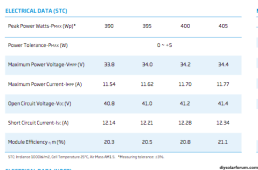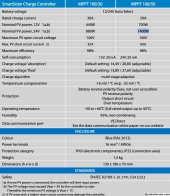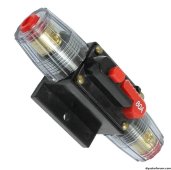Hi
I recently moved home and at the bottom of the garden we have an outbuilding that I'd like to turn into a mancave but has no power (and no practical way to add grid power).
The previous owner had a solar setup of some type as there are 4 x 400W panels on the roof, but no other equipment remains in the building.
The panels are 32.2v & 9.38A each. x4 = 128.8v / 37.5A (I confirmed the voltage is ~correct using a meter)
I'd like to install an MTTP, battery and inverter to replace the missing equipment, I've watched some videos and done some reading but I'd appreciate someone with experience offering advice on my choices below.
For the MPPT I was thinking of using a Victron BlueSolar Charge Controllers MPPT 100/50 - it seems fine for amps (50) but it's maximum PV open circuit voltage is 100V, can I can around this but re-configuring the panels in parallel (64v instead of 128v)? Or should I be looking for an MTTP that can handle the panels in series (which would be helpful as it avoids getting onto the roof) ?
I'm planning to buy a '12V Lifepo4 Battery 100AH 1280Wh Lithium Battery', there seems to be lots of generics on Amazon - are these ok or should I be going for a known brand?
And for the inverter I was planning on this one:
I'd really appreciate any feedback at all. Thanks
I recently moved home and at the bottom of the garden we have an outbuilding that I'd like to turn into a mancave but has no power (and no practical way to add grid power).
The previous owner had a solar setup of some type as there are 4 x 400W panels on the roof, but no other equipment remains in the building.
The panels are 32.2v & 9.38A each. x4 = 128.8v / 37.5A (I confirmed the voltage is ~correct using a meter)
I'd like to install an MTTP, battery and inverter to replace the missing equipment, I've watched some videos and done some reading but I'd appreciate someone with experience offering advice on my choices below.
For the MPPT I was thinking of using a Victron BlueSolar Charge Controllers MPPT 100/50 - it seems fine for amps (50) but it's maximum PV open circuit voltage is 100V, can I can around this but re-configuring the panels in parallel (64v instead of 128v)? Or should I be looking for an MTTP that can handle the panels in series (which would be helpful as it avoids getting onto the roof) ?
I'm planning to buy a '12V Lifepo4 Battery 100AH 1280Wh Lithium Battery', there seems to be lots of generics on Amazon - are these ok or should I be going for a known brand?
And for the inverter I was planning on this one:
| Output Waveform | Pure Sine Wave |
| Rated Power | 2500W |
| Peak Output Power | 5000W (<10ms) |
| Frequency | 50Hz ± 2Hz |
| Conversion Efficiency | > 90% |
| Input Voltage | 12V DC (10V-15.5V) |
| Output AC Voltage | 230V ± 5% |
| Low Voltage Alarm | 10V DC ± 0.5V |
| Low Voltage Cut-off | 9V DC ± 0.5V |
| Machine Size | 360 * 160 * 105 (mm) |
| Net Weight | 3kg |
I'd really appreciate any feedback at all. Thanks






